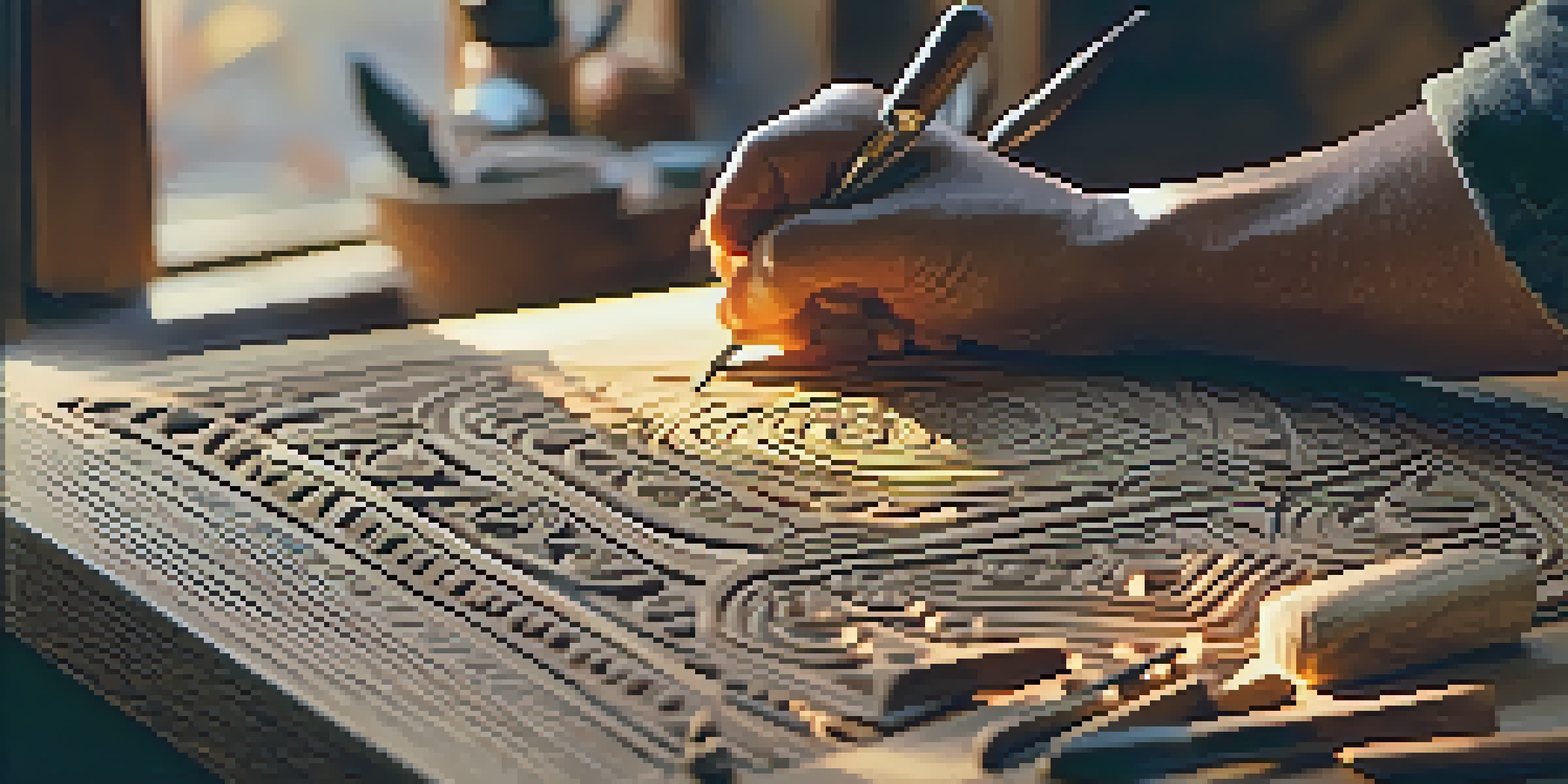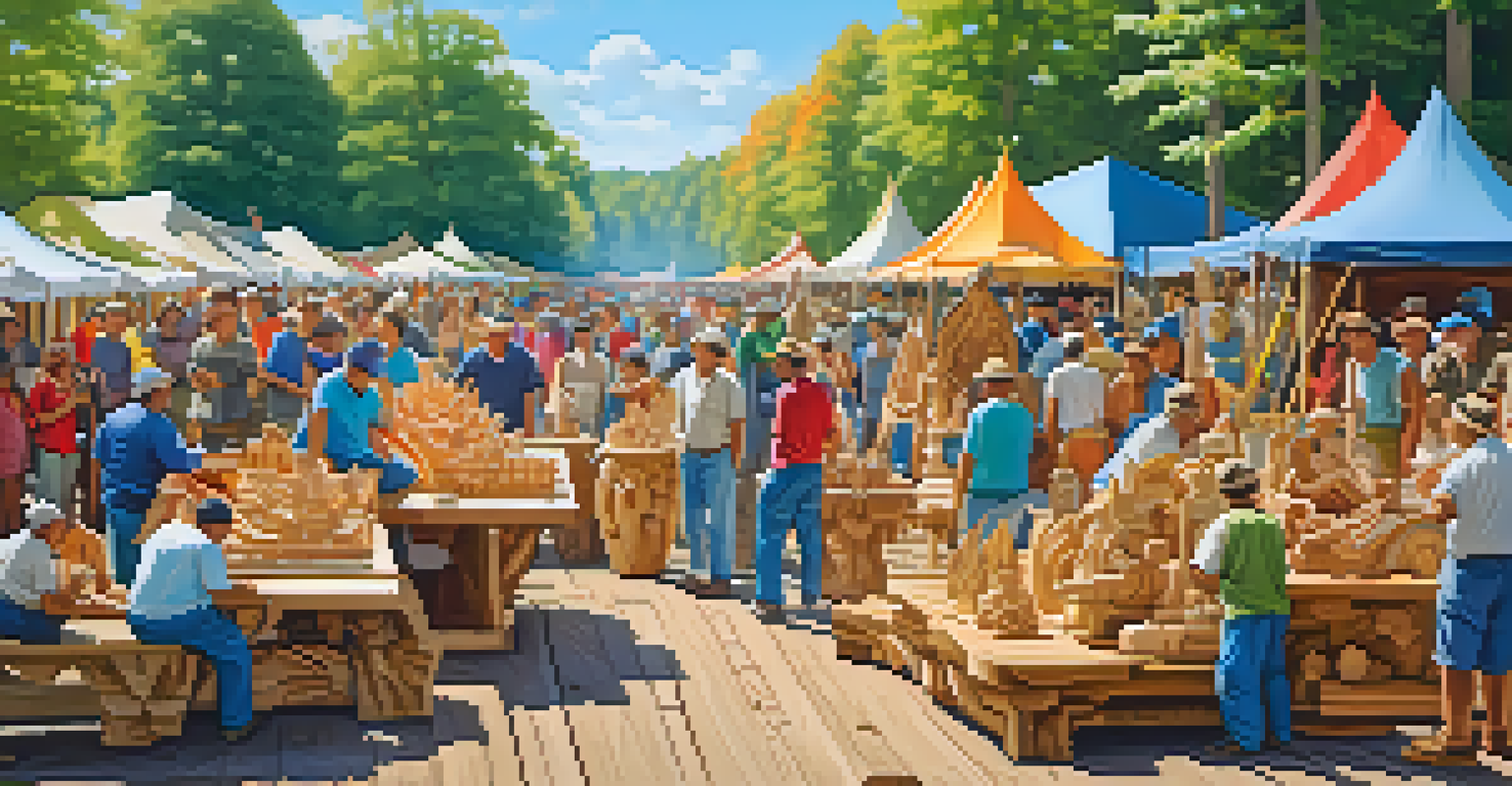Cultural Significance of Carving in Artistic Expression

The Historical Roots of Carving in Various Cultures
Carving as an art form has deep historical roots in many cultures around the world. From ancient civilizations like the Egyptians and Mayans to indigenous tribes, carving has been a method to tell stories, preserve history, and express spirituality. These carved artworks often served practical purposes, like tools or totems, but they also conveyed the beliefs and values of their creators.
Art is the most beautiful of all lies; it is a silent language that speaks to the soul.
For instance, the intricate carvings found in Gothic cathedrals not only showcased artistic skill but also reflected the religious fervor of the time. Similarly, Native American totem poles tell stories of lineage and community, displaying the interconnectedness of life and nature. This rich tapestry of history emphasizes that carving is more than just an artistic expression; it's a vital part of cultural heritage.
Understanding these historical contexts allows us to appreciate the depth of meaning behind carved artworks. As we explore different cultures, we see how each has adapted carving techniques to reflect their unique identities, making it a truly global art form that transcends borders and time.
Carving as a Form of Communication
Carving is often referred to as a 'silent language' that communicates ideas and narratives without words. This form of artistic expression can convey complex emotions and social messages, making it a powerful tool for storytelling. For example, the carvings on ancient stone tablets were used to record laws, events, and cultural practices, serving as a historical record for future generations.

In contemporary times, artists use carving to address social issues, creating pieces that provoke thought and inspire change. These modern carvings can reflect personal experiences or broader societal concerns, connecting audiences to the artist's message. Just as the ancient artisans spoke through their work, today's carvers continue this tradition, using their skills to engage with pressing topics.
Carving as Cultural Heritage
Carving serves as a vital medium for storytelling and preserving cultural identities across various societies.
This ability to communicate through carving highlights its importance in both personal and communal contexts. It bridges gaps between generations and cultures, allowing for a rich dialogue that extends beyond spoken language.
The Spiritual and Ritualistic Aspects of Carving
Throughout history, carving has held significant spiritual and ritualistic meanings across various cultures. Many societies believe that carved objects possess a spiritual essence or connection to the divine. For instance, African tribal masks, often intricately carved, are used in ceremonies to connect with ancestors and the spirit world.
The purpose of art is not a rarified, intellectual distillate; it is life, intensified, and the act of carving is a direct expression of that life.
Similarly, in Buddhist culture, the act of carving is seen as a meditative practice that fosters mindfulness and tranquility. Carved images of Buddha serve as reminders of spiritual teachings, guiding practitioners on their path to enlightenment. This intertwining of art and spirituality emphasizes how carving can transcend the physical realm.
These spiritual dimensions of carving not only enrich the artistic process but also imbue the artworks with deeper significance. They serve as a testament to humanity's search for meaning, illustrating how art can become a conduit for spiritual expression.
Carving Techniques: Tradition Meets Innovation
Carving techniques have evolved dramatically over the centuries, blending traditional methods with modern innovations. Traditional carving often involves tools like chisels and knives, requiring immense skill and precision. Artisans have passed down these techniques through generations, ensuring that the cultural significance of carving endures.
However, contemporary artists are now experimenting with new materials and technologies, such as digital carving and 3D printing. This fusion of old and new not only expands the possibilities of carving but also invites a fresh dialogue about the meaning of craftsmanship in today's world. For instance, artists can now create intricate designs that were previously unimaginable, pushing the boundaries of what carving can achieve.
Carving's Communicative Power
This art form acts as a 'silent language,' conveying complex emotions and social messages without spoken words.
The interplay between tradition and innovation in carving reflects the dynamic nature of cultural expression. As artists navigate this landscape, they honor their heritage while also paving the way for future generations to explore new avenues of artistic creativity.
The Role of Carving in Community Identity
Carving often plays a pivotal role in shaping community identity, acting as a visual representation of shared values and beliefs. Local artisans frequently collaborate on community projects, creating large-scale carvings that celebrate their heritage. These collaborative efforts not only strengthen community bonds but also foster a sense of pride in cultural identity.
Take, for example, the annual wood carving festivals held in various regions, where artists come together to showcase their skills and celebrate their culture. These events draw visitors from far and wide, highlighting the importance of carving as a communal activity. Through these gatherings, communities pass down techniques and stories, ensuring that their cultural legacy continues.
By emphasizing the community aspect of carving, we see how art can unite people and reinforce a collective identity. It serves as a reminder that creativity is not just an individual pursuit but a shared experience that enriches the fabric of society.
The Therapeutic Benefits of Carving
Beyond its artistic value, carving offers therapeutic benefits that can greatly enhance mental well-being. Engaging in this form of art allows individuals to express emotions, relieve stress, and channel their creativity in a constructive way. The rhythmic motions of carving can be meditative, providing a calming effect that promotes mindfulness.
Many therapeutic programs now incorporate carving as a form of art therapy, helping participants process trauma or grief. By focusing on the act of carving, individuals can find a sense of purpose and accomplishment, allowing for personal healing. This transformative power of art highlights how carving can serve as a tool for emotional expression.
Therapeutic Benefits of Carving
Engaging in carving can provide emotional relief and promote mindfulness, highlighting its therapeutic value in modern life.
As we recognize the therapeutic benefits of carving, it becomes evident that this age-old practice holds relevance in our modern lives. It invites us to not only create but also reflect on our experiences, fostering a deeper connection with ourselves and the world around us.
Preserving Carving Traditions in a Globalized World
In an increasingly globalized world, the preservation of traditional carving techniques is more important than ever. As cultures blend and evolve, there is a risk that unique carving styles and methods may be lost. Efforts to document and teach these techniques are crucial in ensuring that future generations can appreciate and continue these art forms.
Many organizations and artisans are working tirelessly to keep traditional carving alive, offering workshops and educational programs that engage younger audiences. These initiatives not only teach skills but also instill an appreciation for the cultural significance of carving. By fostering a sense of pride in one’s heritage, we can encourage the next generation to carry these traditions forward.

Preserving these carving traditions enriches our global cultural landscape and serves as a reminder of the diverse narratives that shape our world. It highlights the importance of understanding and respecting the artistry that connects us all, regardless of our backgrounds.